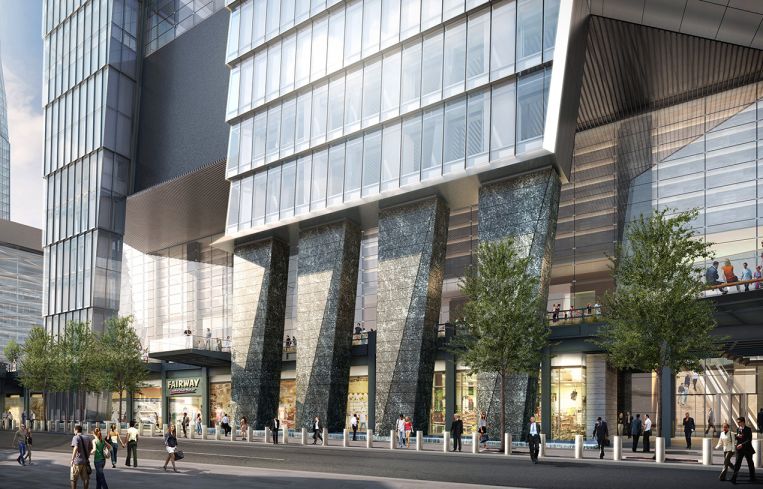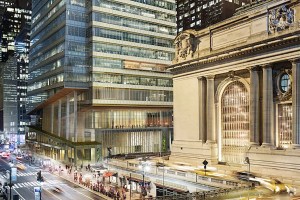Real Estate Experts Look Back on 2015, and What Lies Ahead in 2016
By Terence Cullen December 16, 2015 9:30 am
reprints
It’s tough to follow an act like 2014, when New York City saw 30 million square feet of leasing activity and three of the biggest brokerage mergers in the last decade.
And while leasing activity in 2015 is down about 14 percent from December of 2014, the last 12 months has proved stronger than normal. That included 23.3 million square feet leased this year in Manhattan in the first 10 months of the year, according to the latest data from Cushman & Wakefield. For the second year in a row, that activity has circled around Downtown and the Far West Side. The biggest surprise was Brooklyn, where the top 11 transactions totaled more than 650,000 square feet of leasing activity during 2015’s third quarter, according to CBRE market data. As a result of these big moves throughout the city, several industry leaders said the lines between Manhattan submarkets are starting to blur.
“This year hasn’t been as robust as 2014, but still relatively healthy,” said Mitchell Steir, the chairman and chief executive officer of Savills Studley. “[This year], I think for the most part, has been about headline deals both in-process at the World Trade Center, and those that have committed at the rail yards, cementing both locations and making people aware that the rail yards are happening.”
There were five single-property sales that fetched more than $1 billion, including the Helmsley Building and the Crown Building (See our story on page 12). But two of the biggest sales transactions were DTZ’s $2 billion buy of C&W, which closed in September, and the $5.3 billion purchase of Stuyvesant Town-Peter Cooper Village that’s expected to end a messy, nine-year saga when it closes later this month.
2015 started with the indictment of Sheldon Silver, who was charged with referring real estate developers to a law firm that gave him kickbacks, and ended with the former all-powerful Assembly speaker’s conviction on all counts, and then two weeks later with the conviction of Dean Skelos, the former Senate majority leader, in his own real estate-tinged corruption trial. Zoning proposals and development tax breaks are hot topics going into 2016, especially as the 421a tax abatement for rental buildings faces extinction.
“[Any new proposal has] got to make economic sense,” said William Rudin, the vice chairman and CEO of Rudin Management Company and head of the pro-business Association for a Better New York. “If it doesn’t make economic sense, then no developer is going to risk their capital and their time to develop affordable housing, which is critical to the continued growth of our city.”
Downtown and to the West
The headline commercial real estate deals of this year were mostly focused on the Far West Side, where white-shoe law firms, insurance companies and even the coveted tech, advertising, media and information, or TAMI, tenants committed to move into new office space by the end of this decade.
Related Companies and Oxford Properties Group announced roughly 365,000 square feet leased at 10 and 55 Hudson Yards (two of its three office towers) to the likes of The Boston Consulting Group, VaynerMedia and Boies, Schiller & Flexner. That’s not even mentioning the office condominium sales at the developers’ 30 Hudson Yards to private equity firm KKR and banking giant Wells Fargo. Related and Oxford topped out the 52-story 10 Hudson Yards this fall and Coach and other tenants will begin assuming their space in the spring. (Coach is reported to be shopping around the condo with plans to lease back its space.)
But one of the bellwether deals came across the street at Brookfield Property Partners’ Manhattan West, where Skadden, Arps, Slate, Meagher & Flom signed a 550,000-square-foot lease. The law firm will leave 4 Times Square for 1 Manhattan West—a 2.1-million-square-foot office tower at the corner of West 30th Street and Ninth Avenue.
“They’re an international, significant legal power,” said Kevin Singleton, an executive vice president at TF Cornerstone and the head of the Hudson Yards Business Improvement District. “What they bring to the population there is a wide range of workers…as well as a significant number of operations and support staff. They’ll find retail components, all sorts of offerings there that they’ll want to stay. They may even want to move there [to live].”
As the big companies gobbled up pre-development offices by the hundreds of thousands of square feet, media companies continued assuming Downtown space and signing leases for what some are calling the new media capital of the world. Time Inc. started moving its several print and online media companies into Brookfield Place this fall, and the developer recently brought Cambridge University Press to One Liberty Plaza.
New York Mets broadcaster SNY will move its offices and studio from 1271 Avenue of the Americas to 4 World Trade Center, taking up 83,000 square feet. Developer Silverstein Properties will make a bigger splash next year: the company is negotiating with Rupert Murdoch to move his News Corp. and 20th Century Fox companies into 1.5 million square feet at the Bjarke Ingels-designed 2 World Trade Center.
“We’re excited by that,” said Larry Silverstein, the chairman of Silverstein Properties. “We’re ready to start building it and get the reaction from potential users for the space.”
The Alliance for Downtown New York announced earlier this year that these mass relocations will increase Lower Manhattan employment by 40,400 jobs between 2015 and 2019. The business district, crippled first by 9/11 and then by a withered Wall Street, has bounced back thanks to a diversified mix of tenants, said Downtown Alliance President Jessica Lappin.
Average rental rates Downtown are up more than 20 percent this year to about $60 per square foot, according to C&W’s numbers. Although the market is seeing new signs of life, it’s still a comparable discount to the bustling Midtown South, where the average rent is about $66 per square foot, or Midtown’s $77 per square foot.
“You’ve still seen some strong activity throughout the market,” said Richard Persichetti, a vice president of research, marketing and consulting for C&W. “Rents are up, but it’s still a value play for tenants.”
A growing trend that’s emerged this year is companies shedding their brand as a Midtown- or Downtown-only tenant and moving to different parts of the city, said Mary Ann Tighe, CBRE’s New York tristate region CEO. Typically, Ms. Tighe said, companies have looked to move a few blocks from their current locations.
“It used to be ‘location, location, location,’ which fundamentally meant the locations people were [already] in,” Ms. Tighe said referring to Midtown, Midtown South and Downtown. “It’s really a very narrow scope. This year, it’s really ‘location, location, location’ means from the Battery to 60th Street and from river to river.”
Brooklyn, Brooklyn, Take Them in
The Brooklyn waterfront emerged this year the same way a debutante does at a coming out party.
Tishman Speyer in July agreed to buy part of the Downtown Brooklyn Macy’s building at 422 Fulton Street, and will develop 10 floors of office space at the location. Quinlan Development started work renovating 41 Flatbush Avenue. And last month JEMB Realty announced it was building a ground-up project that will lead to 400,000 square feet of office space—the first new commercial development in the 10 years since the neighborhood was rezoned.
“That goes to show—with companies of pedigree and tradition like that coming here—it’s not just a flash in the pan,” said Tucker Reed, the president of the Downtown Brooklyn Partnership.
Indeed, the projects are welcome news to the business district, which had a 3.4 percent vacancy rate for its 17 million square feet of inventory during the first half of the year, according to the partnership.
New office product is coming online as the residential development of Brooklyn takes full effect. City Point, the 1.7-million-square-foot mixed-use project in Downtown Brooklyn, is slated to be completed next year, bringing the likes of Target, Trader Joe’s and Century 21 to the neighborhood.
“Brooklyn is no longer a value play; it’s a lifestyle choice,” said MaryAnne Gilmartin, the CEO of Forest City Ratner Companies, which is developing the 6,000-unit Pacific Park project. “We think the innovative economy is alive and well in Brooklyn.”
That’s especially true for the Brooklyn Navy Yard and Sunset Park. Rudin Management and Boston Properties are doing their own ground-up project at Dock 27, a 675,000-square-foot development in the Navy Yards, of which WeWork is anchoring it with 222,000 square feet.

“I think we’ve impacted the general marketplace in Brooklyn,” Mr. Rudin said. “There seems to be a great, great interest in people wanting to have their businesses near where their employees are.”
It’s not just longtime Manhattan developers crossing into Brooklyn, but also tenants. Time Inc. will move 300 creative and innovative employees to the 6-million-square-foot Industry City; Amazon has signed a lease memorandum for space at the neighboring Liberty View Industrial Plaza. A source familiar with the negotiations said the e-commerce giant is taking a full floor at the 1-million-square-foot former naval warehouse.
Brokerages are starting to take notice, too. This year, CBRE and JLL released for the first time submarket reports on the Brooklyn waterfront. And Newmark Grubb Knight Frank this year expanded its foothold in the borough by opening a leasing office.
Biggest Moves
Two of the biggest purchases of the year weren’t of a single building—or even a building at all. In March, DTZ kicked off its $2 billion buy of C&W. The sale closed in November and Brett White, who had served as a chairman of DTZ before the purchase, is leading the venture. The new company, bearing the C&W moniker with a new logo, now has 43,000 employees and a projected $5 billion in revenue.
“Where they were weak, we were strong,” said Ron Lo Russo, the head of the firm’s New York tristate region. “Where we were weak, they were strong.”
The largest sale of the year went to the Blackstone Group and Ivanhoé Cambridge, which is paying $5.3 billion for the 11,232-unit Stuyvesant Town-Peter Cooper Village.
Blackstone and Ivanhoé Cambridge’s sale is expected to close at the close of this year, ending a messy saga that began with Tishman Speyer and Blackrock’s record-setting $5.4 billion purchase in 2006. That ownership handed over the keys to its lenders in 2010 after defaulting, and Stuy Town-Peter Cooper Village has been under CWCapital Asset Management’s control since last year.
Protecting affordable housing was crucial to the transaction, said local Councilman Daniel Garodnick, a lifelong resident of the development.
“It was the largest preservation deal in the city’s history,” he said. “Time will tell here, but it is clear that they are making efforts to engage with the community in the way we have not seen in the last 10 years.”
Give It a Break, Albany
The coming year will surely be a busy one in Albany—not just because the entire legislature is up for re-election. Following the indictments of Silver and Mr. Skelos, the legislature was able to overhaul rent regulation last June and raise the rent threshold for what can become a market-rate apartment.
But the lucrative 421a tax abatement only got a straight extension until the end of this year. Gov. Andrew Cuomo has left it up to the Real Estate Board of New York and the Building and Construction Trades Council of Greater New York to hammer out a prevailing construction wage by this coming January. If there’s no compromise, the governor said, 421a talks are dead and the tax break will expire.
Developers CO spoke to noted how important the tax break is to building rentals in New York City, as construction costs rise (its importance is in play in Mr. Skelos’ corruption trial right now). In its current state, developers receive a 25-year tax break in exchange for making 20 percent of a building’s units below value. Mayor Bill de Blasio has proposed extending that to 35 years in exchange for a larger percentage of affordable units. New York University’s Furman Center for Real Estate and Urban Policy found in a report earlier this year that hizzoner’s proposal wouldn’t hinder developer’s profits, if already rising construction costs stay flat.
But some are worried that a deal won’t be hammered out in time; 421a might not be in effect for 2016, Ms. Gilmartin said, slowing construction considerably.
“Instead of doing everything in the world to encourage housing in New York, politicians are dicking around over a few nickels and dimes,” declared Francis Greenburger, the chairman and CEO of Time Equities. “For them not to encourage building as much housing as possible to me is crazy.”
If that’s the case, it might put a big dent in a booming construction industry. The New York Building Congress puts 2015 overall construction spending at $39 billion, up 10 percent from a year earlier. Spending will make records; next year, it is forecasted to hit $41 billion, and $40.8 billion in 2017.
Airing It Out in Midtown East
For the second time in less than three years, the broader rezoning of Midtown East is set to go into discussions. The city was successful this year in green-lighting the special zoning permit for SL Green Realty Corp.’s 1 Vanderbilt and the broader Vanderbilt Corridor between East 42nd and East 47th Streets. Developers can now invest in mass transportation sites nearby a project in this special zone in exchange for a higher floor-to-area ratio.

But the steering committee for Midtown East—co-led by Mr. Garodnick and Manhattan Borough President Gale Brewer—released its recommendations this fall for the broader rezoning between East 39th and East 57th Streets. Developers either have the option for higher density through the mass transit options, or buying the available development rights above landmarks anywhere in the Midtown East district at market rate.
“The important part of what we did there was that we took the best elements of the Vanderbilt rezoning and applied them to the great east Midtown area,” Mr. Garodnick said.
At the same time, the city is gearing up for a battle between preservationists and affordable housing advocates. Borough presidents have lambasted Mr. de Blasio’s proposal to allow greater density in exchange for more affordable units.
“I’m glad the administration has finally begun taking our concerns seriously, but these plans need major changes before we can accept them,” Ms. Brewer said in a statement after her borough board—made up of community board chairs and local councilmembers—killed the proposal last month (four councilmembers abstained from voting).
“They’re picking the right locations,”contended Richard Anderson, the president of the Building Congress. “If the mayor doesn’t achieve something along these lines, his affordable housing program is doomed before it is born.”
Look to the Future
While some industry vets are worried about a slowdown and rising interest rates, many are positive that 2016 will be another blockbuster year for New York City real estate with continued high leasing activity and construction all over the city (see our story on page 40).
The Far West Side and Downtown will continue garnering attention, but that doesn’t mean Midtown will suffer. Ms. Tighe said asking rents in the neighborhood could hit the record rates set at the top of the last cycle in 2008. Renewed hiring in the financial sector has spurred interest for Midtown-based companies to expand, several industry leaders added.
And with companies vacating Midtown properties in the coming years as they head to new offices, the buildings they’re vacating will start to be repositioned, said David Falk, the president of NGKF’s New York tristate region. In past years, that might have just meant a spruced up lobby and new elevators. But in the coming years, he added, it will be more about landing TAMI tenants who have outgrown the offices of Midtown South.
“Landlords are trying to reinvent [their buildings] with the vision that it could be [for] that progressive user that maybe couldn’t find a 40,000-square-foot floor plate in Midtown South,” Mr. Falk said. “If they go to Midtown, they can create it within their four walls. You’re going to start to see that.”
With additional reporting provided by Liam La Guerre.



